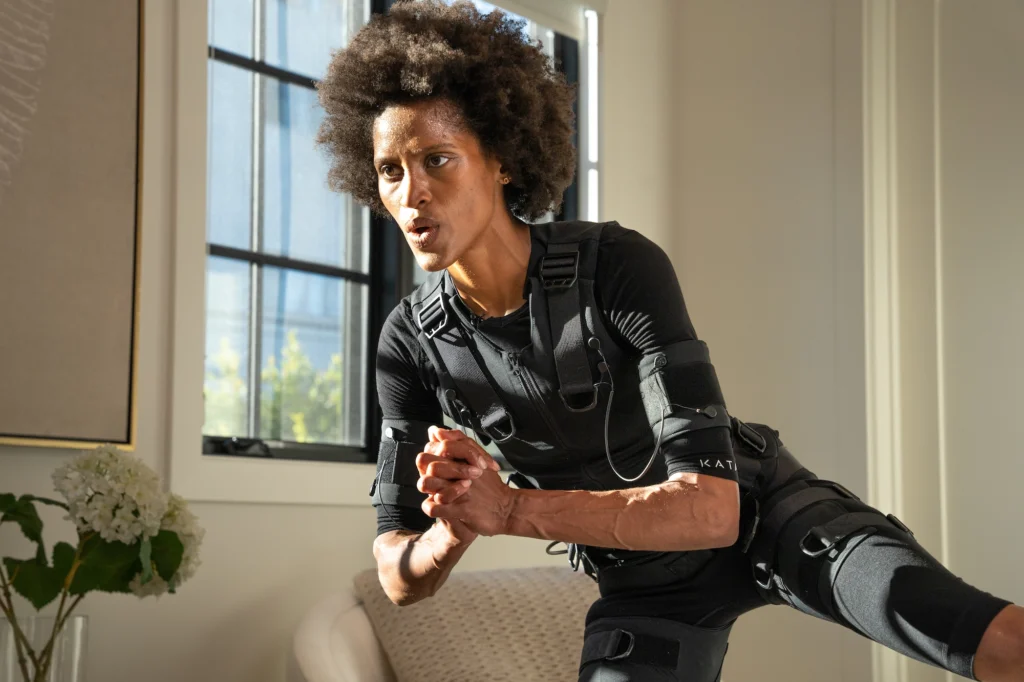
Unlike EMS concepts that involve visiting a specialized studio, Katalyst delivers an FDA-cleared bodysuit directly to people’s homes
Groundbreaking technological innovations often take time to gain mainstream acceptance before eventually breaking through and fundamentally changing the way we interact with the world.
Bjoern Woltermann is hoping that’s the case with electro muscle stimulation (EMS) fitness, a training method that involves working out while wearing a bodysuit that sends electrical currents to your muscles. EMS activates twice as many muscle fibers as traditional exercise, which its proponents say allows people to achieve the same or better workout results than traditional exercise in a fraction of the time, with a 20-minute, full-body EMS session replacing an hour or more in the gym.
Inspired by his personal journey of using EMS training to recover from chronic lower back pain, Woltermann founded Katalyst in 2015. The goal behind Katalyst, Woltermann says, is to democratize access to the transformative power of EMS.
Unlike other EMS concepts on the market which involve trips to a specialized fitness studio, Katalyst delivers an FDA-cleared EMS suit directly to people’s homes. Katalyst owners get access to an app with personalized, guided workouts delivered by expert trainers that are designed for people of all fitness levels.
Woltermann spoke with Athletech News about why he fell in love with EMS, his vision for the future of Katalyst, and what it will take for EMS fitness to gain mainstream acceptance.
This conversation has been lightly edited for clarity and length
Athletech News: What inspired you to create Katalyst?
Bjoern Woltermann: I was born and raised in Germany, and had lower back issues for years. I was in the air force when I was young, and they basically told me I couldn’t sit on a plane for an extended period of time, so I didn’t pursue that career path. Around 15 years later, I had an executive job at Deutsche Telekom where I was flying 150 days a year. My lower back blew up, and I had to be on painkillers 20 days a month. In 2012, my physician sent me to an EMS training studio in Berlin. I was very skeptical at first, thinking it all sounded too good to be true, but I tried it and was blown away by the experience. I’d never felt my body like that.
But the real reason I got interested in EMS is because when I walked into the studio, I saw a 60-year-old female working out besides a 35-year-old male, doing the same stuff. I’m a behavioral economist by training, so I see the world in a different way. I asked the 60-year-old woman, ‘‘Why are you doing this?” And she said, “I can play with my grandchildren and I can carry my groceries again.” That had a profound impact on me because it’s not what you normally hear from people in a gym setting. I did some research and found out that EMS didn’t really exist in the United States (the concept is more popular in Europe and other parts of the world). Along with being an EMS customer and wanting a better solution for myself, it all came together and I decided to start Katalyst in 2015.

ATN: EMS is often seen as a highly specialized fitness activity. How big can the market get for Katalyst?
BW: I believe full body electro muscle stimulation training as a category will be the electric toothbrush of fitness. Around 20 or 30 years ago, people thought, “Why do we need an electric toothbrush? We have normal ones.” Now everybody has one and we buy them in Costco. They became normal because it made something easier, which is what tech should do. Now, for the very first time in fitness, technology is making something easier. EMS technology has been around for quite some time, and it actually works. It’s not a hack. I haven’t lifted weights in eight years, the only thing I do is push-ups, pull-ups and Katalyst, because that’s all I can do. I can’t lift heavy weights because my disks don’t support it. But I’m in the best shape of my life.
ATN: Who makes up Katalyst’s target customer base?
BW: There are two answers to that. The total addressable market is everyone who doesn’t have a pacemaker and who is not pregnant. We have customers who are active duty special forces, we have athletes, people in their mid-career or moms who don’t have time but still want to stay in shape, all the way to elderly people. We’ve even had people that use EMS as prehab for hip replacement surgery.
However, the first adopter market is people who are already in the mindset of, “I want to do more with my body and I want to increase my healthspan and lifespan.” That’s our first group because they’re already looking for EMS, we don’t have to educate them.
ATN: Why did you make Katalyst an at-home product compared to other EMS options that require a visit to the studio?
BW: The studio model has been around for about 15 years, there are over 10,000 studios worldwide. It’s a massive market, but it’s an expensive product. How many people can afford personal training? I really want to democratize this technology, so instead of paying something like $100 for two sessions you can buy a Katalyst and use your EMS suit as often as you want and take it wherever you go. Coming back to the electric toothbrush analogy, people wouldn’t use it if they had to go to the dentist every time they wanted to brush their teeth.
It’s also more accessible. You don’t have to live in a big city and be within 10 minutes or 15 minutes of a studio. You can be somewhere like northern Montana and as long as you have internet, you’re good.

ATN: What does a typical Katalyst EMS workout look like?
BW: Our suit is fully flexible and lightweight, so it supports four modes of training: Strength, Power, Cardio and Recovery. The Strength Mode has parameters that simulate slow twitch muscle fiber activation to improve general strength in your body. The Power Mode has a higher frequency, which activates type-two fast twitch muscle fibers like we use in sprinting and jumping. For an older person, it can help them stop themselves from falling if they trip. The Cardio Mode gives intermittent signals, so you can do movements like jumping jacks and air squats on your own, or you can combine the system with a treadmill. Our Recovery Mode is very slow twitch and creates a pumping sensation, so you can add it in for a few minutes after a workout to increase blood flow, nutrient distribution, lactic acid breakdown, etc. We also have sports-specific activities, like golf workouts that are good for rotational stability and swing speed, and an MMA coach who teaches boxing.
ATN: Can EMS be the only workout people do?
BW: It really depends. We have people who don’t have a fitness routine who become addicted to EMS to where they do this as their only fitness activity. People who are already doing other fitness activities can use EMS as a supplement, like on off days when they don’t have enough time to go to the gym or or when they’re traveling. Other people use it to recover from issues like back pain or knee pain, or if they have trouble activating their glutes, for example.
ATN: How much work still needs to be done to educate American consumers about the benefits of EMS?
BW: America is basically 10 years behind the rest of the world when it comes to EMS, so there’s definitely a learning curve. In the fitness industry, people have been oversold quite a bit, so when things sound too good to be true, people are skeptical, and that’s normal. But whenever someone tries our product, they’re absolutely blown away. We basically have a 100% conversion rate. So word of mouth is our biggest strength right now.
Long-term, I want us to get to where EMS is known and it’s considered normal to have tried it and own a suit. That’s a 20-year goal, probably. It took that long for the electric toothbrush. In the short term, it’s more about getting our name out there and being known as an option.

